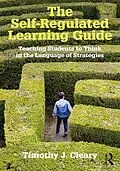The Self-Regulated Learning Guide introduces K-12 teachers to the basics of self-regulation. Highly practical and supported by cutting-edge research, this book offers a variety of techniques for seamlessly infusing self-regulated learning principles into the classroom and for nurturing students' motivation to strategize, reflect, and succeed. Featuring clear explanations of the psychology of self-regulation, these nine chapters provide teachers with core concepts, realistic case scenarios, reflection activities, and more to apply SRL concepts to classroom activities with confidence.
Autorentext
Timothy J. Cleary is Associate Professor in the Graduate School of Applied and Professional Psychology at Rutgers University, USA.
Klappentext
The Self-Regulated Learning Guide introduces K-12 teachers to the basics of self-regulation. Highly practical and supported by cutting-edge research, this book offers a variety of techniques for seamlessly infusing self-regulated learning principles into the classroom and for nurturing students' motivation to strategize, reflect, and succeed. Featuring clear explanations of the psychology of self-regulation, these nine chapters provide teachers with core concepts, realistic case scenarios, reflection activities, and more to apply SRL concepts to classroom activities with confidence.
Zusammenfassung
The Self-Regulated Learning Guide introduces K-12 teachers to the basics of self-regulation. Highly practical and supported by cutting-edge research, this book offers a variety of techniques for seamlessly infusing self-regulated learning principles into the classroom and for nurturing students' motivation to strategize, reflect, and succeed. Featuring clear explanations of the psychology of self-regulation, these nine chapters provide teachers with core concepts, realistic case scenarios, reflection activities, and more to apply SRL concepts to classroom activities with confidence.
Inhalt
SECTION I Preparing for Your SRL Journey 1. SRL LOOP: The Conceptual Foundation 2. Motivation: Fueling the SRL Loop 3. Strategies: Tools for Directing the SRL Loop SECTION II Digging a Little Bit Deeper 4. Forethought: Setting the Stage for Learning 5. Feedback: The Role of the Teacher 6. Feedback: Shifting Responsibility to the Student 7. Self-Reflection: Making Sense of the Feedback SECTION III Bringing it All Together 8. Teaching SRL Skills: Classroom Testing Activities 9. Teaching SRL Skills: Classroom-Based Lessons and Activities Final Thoughts
